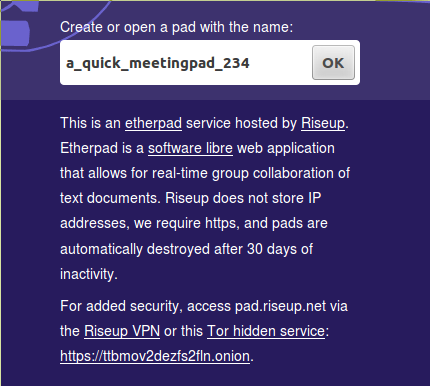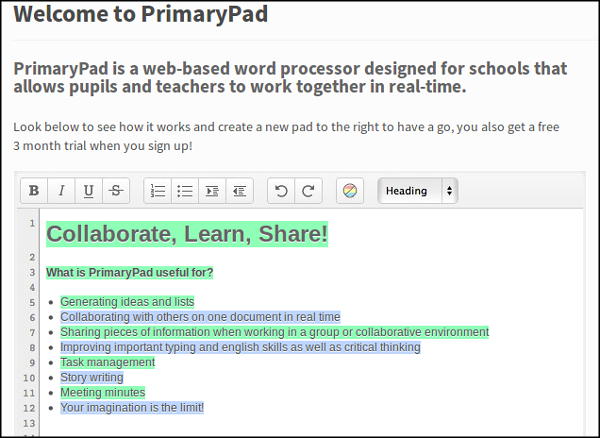Case Studies
The following case studies should give you some background information and ideas about how Etherpad can be used.
Case Study: P2PU.org Community calls
Etherpad is used as a tool for the Peer to Peer University community for their "community calls" and on-going planning. Invitations with a link to the pad are circulated. While other tools are used the pad is the key tool. A link to a Google HangOut (an online chat tool), links to additional pads detailing past meetings and projects.
Using Etherpad helps to removes the barriers to entry. Anyone can click on the link and start editing. For this community there are conventions to the use of the pad. One of those conventions is to make it clear to see who is editing what part of the pad, new users sign in as attendees. This will link their names to whatever they write.

The pad is used in combination with voice and text chat. Sometimes the talk will go quiet and people will concentrate on adding information to the Etherpad adding it form memory, cutting and pasting text from from different sources or linking out to more in depth information. The weekly meeting process encourages the disparate team to pool information to have it visible in one space. The real time element focuses attention on the task and ensures that there isn't a project drift in terms of not finishing the work in time.
Case Study: Pads for use in activism
Etherpads have been used by many activist communities. Often these pads are not secure in the sense that they are password protected but they do offer the possibility of anonymous collaboration. Two commonly used pads are pad.riseup.net and piratepad.net. Pads have been used for a wide variety of causes from Anonymous to co-ordinate hacktivism 1 to groups in Spain for civic action. 2
Unlike a tool like Google Docs where users need to log in to collaborate, this is not needed for Etherpads. While most large scale services log information like the IP address (identifying addresses) of connecting users, it is possible to configure an Etherpad server not to keep any record of the users who connect to it. However, removal of logs in this way and the lack of user log-ins make these pads practically anonymous.

Case Study: Primary Pad
Primary Pad is an installation of Etherpad set up by a teacher who saw the value of pads for school-based educators. It is based at the website http://primarypad.com. The list of potential uses listed on the Primary pad include:
- Generating ideas and lists
- Collaborating with others on one document in real time
- Sharing pieces of information when working in a group or collaborative environment
- Improving important typing and written skills as well as critical thinking
- Task management
- Story writing

The site contains links to other resources which outline ideas 3 for how Etherpad can be used in the class room. 4
- http://www.theatlantic.com/technology/archive/2010/12/what-its-like-to-participate-in-anonymous-actions/67860/^
- http://arstechnica.com/tech-policy/2011/05/german-police-seize-pirate-party-servers-looking-at-anons-toolkit/^
- http://digitalclass.wordpress.com/2009/04/07/two-uses-of-etherpad-in-the-classroom-to-promote-higher-order-thinking-skills/ ^
- http://ideastoinspire.co.uk/presentations/primarypad.htm?iframe=true&width=720&height=579^





